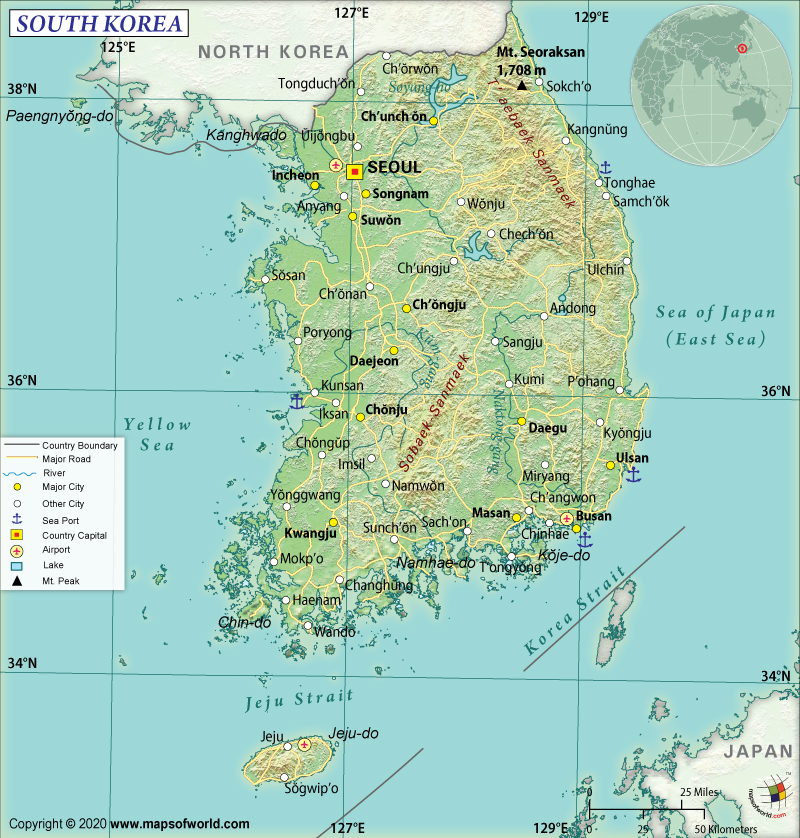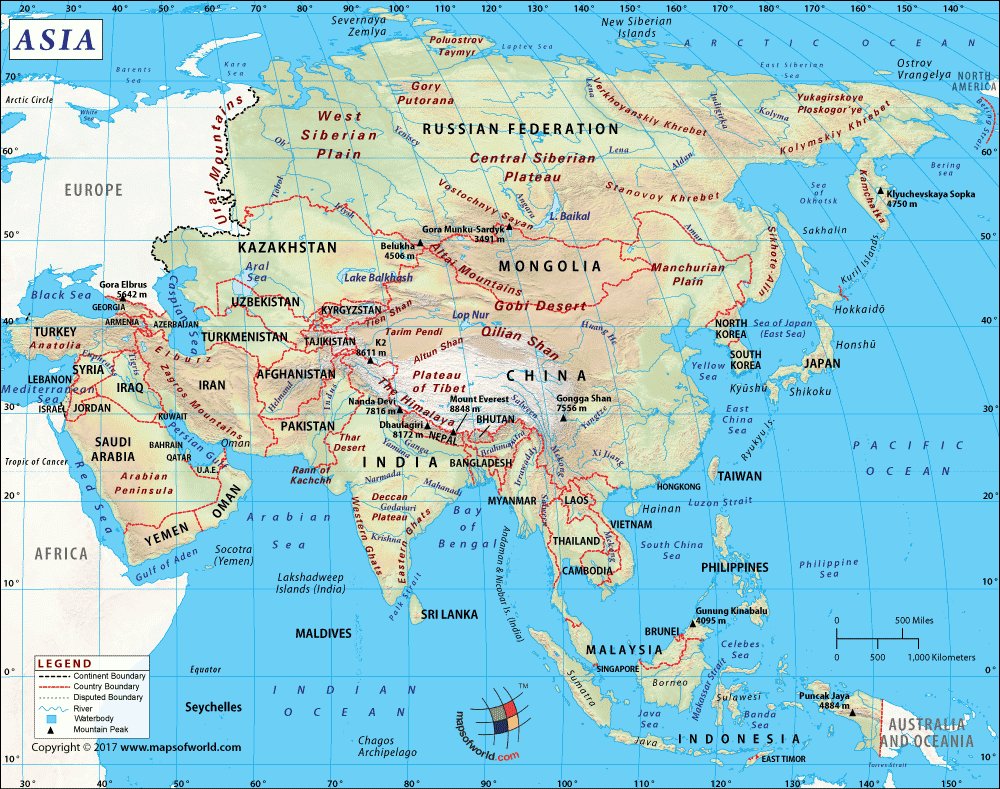What are the Key Facts of South Korea?

|
Official Name |
Republic of Korea |
|
Continent |
Asia |
|
Capital |
Seoul |
|
Largest City |
Seoul |
|
Coordinates |
37.000000, 127.500000 |
|
Area |
38,750 sq. mi (100,363 sq. km) |
|
Land Boundaries |
147 mi ( 237 km) |
|
Coastline |
2,413 mi ( 1,499 km) |
|
Currency |
Korean Republic won (₩) (KRW) |
|
Neighboring Countries |
North Korea. Maritime neighbors: Japan, China |
|
Population |
51,446,201 (2017 est.) |
|
Official Languages |
Korean |
|
Major Religion |
Majority not religious |
|
National Day |
15 August (Independence Day) |
|
National Anthem |
“Aegukga” |
|
Form of Government |
Unitary presidential constitutional republic |
|
President |
Moon Jae-in |
|
Prime Minister |
Chung Sye-Kun |
|
GDP per capita (PPP) |
$ 40,479.3 (World Bank, 2018) |
|
GDP per capita (nominal) |
$ 31,362.8 (World Bank, 2018) |
|
HDI |
0.903 (2017), Rank: 22 |
|
Literacy Rate (%) |
NA |
|
Space Agency |
Korea Aerospace Research Institute (KARI), Korea Astronomy and Space Science Institute (KASI) |
|
Military Expenditure Ranking |
10 (SIPRI, 2017) |
|
No. of Olympic Medals |
337 (as of 2018) |
|
Driving Side |
right |
|
Calling Code |
+82 |
|
Time Zone |
UTC+9 (Korea Standard Time) |
|
Internet TLD |
.kr |
Where is South Korea?
South Korea is the southern half of the Korean Peninsula that is located in Eastern Asia. Its coastline is surrounded by the Sea of Japan to the east, Yellow Sea (also called West Sea) to the west, and the East China Sea to the south. South Korea shares its border with North Korea (237 km or 147 mi).
What is the Geography of South Korea?
South Korea is spread over a total area of 100, 363 sq. km (38,750 sq. mi), out of which 96,920 sq. km (37,421 sq. mi) is land area and 2,800 sq. km (1,081 sq. mi) is water area. The total land boundary is 237 km (147 mi) and the coastline is 2,413 km (1,499 mi).
The mean elevation of South Korea is 282 m (925 ft). While the highest elevation point is Halla-san (an extinct volcano) at 1,950 m (6,398 ft), the lowest elevation point is the sea level at Sea of Japan. The two major mountain ranges of South Korea include the Sobaek Mountains and the Taebaek Mountains.
At the same time, South Korea’s geography can be categorized into 4 general regions. The eastern region consists of high mountain ranges as well as narrow coastal plains. The western region includes broad coastal plains, rolling hills, and river basins. The southern region includes valleys as well as mountains. The fourth region is the southeastern region, which includes the Nakdong River’s broad basin. Other important river basins are Yeongsan River and Honam plains, that are located in the southwest region. Han River, Geum River, Imjin, Bukhan, and Somjin are the other important rivers of South Korea.
However, only 30% of the total land area is lowland, which is primarily located in the western and southeastern parts of the country. No extensive plains are there and the lowlands are formed due to the erosion of mountains. The terrain consists mainly of hills and mountains. Along the east coast of South Korea, a narrow littoral plain is there. South Korea consists of around 3,000 islands and most of them are small as well as uninhabited.
Further, South Korea is part of the East Asian Monsoon region. Temperate climate can be found in the country. There are 4 distinct seasons. Winter season continues for the longest part of the year and is generally dry and cold. Summer season, on the other hand, is hot and humid. It lasts for a short period of time. Spring and autumn seasons are also short in duration and are quite pleasant.
Ordinarily, the average temperature of the capital city Seoul varies within −5 and −2.5 °C (23 and 27.5 °F) during January and that of July varies within 22.5 and 25 °C (72.5 and 77.0 °F). However, warmer and milder weather can be found in Jeju Island, because of its location in the southern part of the country. The average weather revolves around 2.5 °C (36.5 °F) in January and 25 °C (77 °F) in July.
South Korea gets lots of rainfall, usually over 1,000 mm (39.4 in). In comparison to Taiwan, Philippines, China’s eastern coast, and Japan, the country is less vulnerable to typhoons. The typhoons (causing torrential rains) usually take place in late summer (especially in the month of August).
What is the Economy of South Korea?
The South Korean economy had a nominal GDP of US$1.619 trillion and an annual economic growth of 2.7% in 2018. The Republic of Korea is one of the largest economies in Asia as well as the world. It has not only experienced rapid economic growth but also considerable success in reducing poverty.
An export-oriented economic strategy fueled economic growth. IMF has lauded the South Korean economy for its low state debt as well as high fiscal reserves. Over 95% of the workforce is engaged in the services and industrial sector (70.6% in the services sector and 24.6% in the industrial sector). In fact, the agricultural sector’s contribution to the GDP is just 2.2%. While services contribute 58.3%, industry contributes 39.3% to the GDP.
The estimated unemployment rate was 3.7% in 2017. The poverty rate has decreased significantly in the last few decades. It was hovering around an estimated 14.4% in 2016. A significant rise in poverty and suicide rate among the elderly has come up as a huge challenge for the South Korean government.
What is the Transportation System of South Korea?
South Korea has an advanced transportation system, which includes extensive railway and highway network, airways, ferry services, bus routes, and many more. 100,428 km (62,403 mi) of roadways are there in the Republic of Korea and almost all are paved (92,795 km or 57,660 mi). Only 7,633 km (4,743 mi) of roads are unpaved. 4,193 km (2,605 mi) expressways are present in South Korea. 3,979 km (2,472 mi) long railway network is available in South Korea and all of them are standard gauge. 1,600 km (994 mi). The main seaports of South Korea are Incheon, Busan, Kwangyang, Gunsan, and many more. There are 111 airports in the country, out of which 71 have paved runways and 40 have unpaved ones. 466 heliports are there in the Republic of Korea.
What International Organizations is South Korea part of?
ADB, UN, APEC, UNESCO, ARF, UNHCR, Australia Group, BIS, CD, CICA, CP, EAS, EBRD, FAO, FATF, G-20, IADB, IAEA, IBRD, ICAO, ICCt, ICRM, IDA, IEA, IFAD, IFC, IFRCS, IHO, ILO, IMF, IMO, IMSO, Interpol, IOC, IOM, IPU, ISO, ITSO, ITU, MIGA, MINURSO, MINUSTAH, NEA, NSG, OECD, OPCW, PCA, UNAMID, UNCTAD, UNIDO, UNIFIL, UNMIL, UNMISS, UNMOGIP, UNOCI, UNWTO, UPU, WCO, WHO, WIPO, WMO, WTO, ZC, AfDB (nonregional member), ASEAN (dialogue partner), PIF (partner), OSCE (partner), Paris Club (associate), ICC (national committees), ITUC (NGOs), LAIA (observer), OAS (observer), Pacific Alliance (observer), Arctic Council (observer), SAARC (observer), SICA (observer)
Related Link:


![]()
